

Protect Your Privacy - Student Worksheet (Common Sense Education) Common Sense Education. Resources for Teaching Digital Citizenship. As we continue to move forward into this age of explosive technology use, educators and families must find ways to teach children how to use their phones, tablets, and computers ethically, responsibly, and wisely.
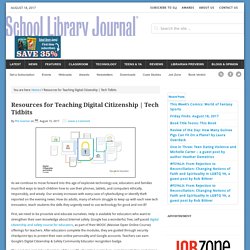
Our anxiety increases with every case of cyberbullying or identify theft reported on the evening news. How do adults, many of whom struggle to keep up with each new tech innovation, teach students the skills they urgently need to use technology for good and not ill? First, we need to be proactive and educate ourselves. Help is available for educators who want to strengthen their own knowledge about Internet safety. 15 Top Resources On Digital Citizenship for 2014.
A lot of the facts you teach your students will be long forgotten by the time they reach graduation, but the hope is that the practical lessons — the ones that can benefit them for years to come — are the ones that will stick.
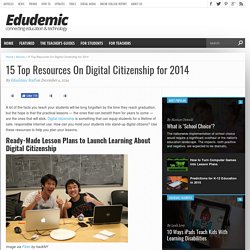
Digital citizenship is something that can equip students for a lifetime of safe, responsible Internet use. How can you mold your students into stand-up digital citizens? Use these resources to help you plan your lessons. Ready-Made Lesson Plans to Launch Learning About Digital Citizenship Image via Flickr by hackNY Ready-made lesson plans about digital citizenship can serve as the perfect launchpad for discussing this topic in class. Digital Citizenship Education in Nine Steps. Today’s students have an online playground in addition to the physical one at their schools.

But unlike school playgrounds, digital spaces are rarely monitored or supervised. As students connect, communicate, and collaborate digitally, they need to learn web literacy, source evaluation, information filtering, and self-monitoring skills. Merely teaching digital citizenship skills is not enough. Think Before You Link. Digital Citizenship Archives - TeachThought. Student Social Media Guidelines final 20131223. 555 best images about Digital Citizenship, Cybersafety, Cyberbullying, Internet Safety on Pinterest. A dozen ways to teach ethical and safe technology use. From The Classroom Teacher's Technology Survival Guide A dozen ways to teach and promote ethical and safe technology use Responsible teachers recognize that schools must give students the understandings and skills they need to stay safe not just in school, but outside of school where most Internet use by young people occurs.

Over-filtered school networks set up a false sense of security; the real world of the Internet is quite different from the Internet at school. Teachers who address safe and ethical Internet use proactively: 1. 2. 3. 4. 5. 6. 7. 8. 9. 10. 11. 12. Will doing those things guarantee that a student will never get in trouble or danger online? Ethical instruction needs to be on going. . * Johnson’s 3 P’s of Technology Ethics: Image source: Digital Footprint Project.
5 Excellent Videos to Teach Your Students about Digital Citizenship. Edutopia is one of my favourite educational web resources .
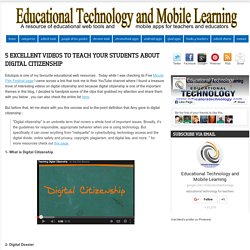
Today while I was checking its Five Minute Film Festival page I came across a link that took me to their YouTube channel where I found a treasure trove of interesting videos on digital citizenship and because digital citizenship is one of the important themes in this blog, I decided to handpick some of the clips that grabbed my attention and share them with you below , you can also check the entire list here.
But before that, let me share with you this concise and to-the-point definition that Amy gave to digital citizenship : "Digital citizenship" is an umbrella term that covers a whole host of important issues. Broadly, it's the guidelines for responsible, appropriate behavior when one is using technology. 12 Good Resources for Teaching Digital Citizenship - A PDF Handout. The 9 essential elements of digital citizenship. Every digital citizen should have these skills To hear author Mike Ribble tell it, kids are entering school with some exposure to technology—meaning schools won’t be making a first impression.
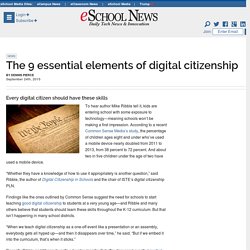
According to a recent Common Sense Media’s study, the percentage of children ages eight and under who’ve used a mobile device nearly doubled from 2011 to 2013, from 38 percent to 72 percent. And about two in five children under the age of two have used a mobile device. 5 Excellent Video Tutorials to Teach Students about Online Safety. The web provides limitless opportunities for learning, creating, sharing, and exploring the depths of human knowledge.
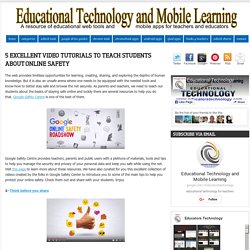
But it is also an unsafe arena where one needs to be equipped with the needed tools and know-how to better stay safe and browse the net securely. As parents and teachers, we need to teach our students about the basics of staying safe online and luckily there are several resources to help you do that. Google Safety Centre is one of the best of them. Google Safety Centre provides teachers, parents and public users with a plethora of materials, tools and tips to help you manage the security and privacy of your personal data and keep you safe while using the net.
Visit this page to learn more about these resources. 2- Protect your stuff.